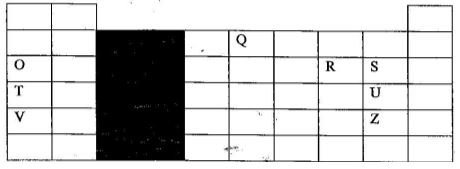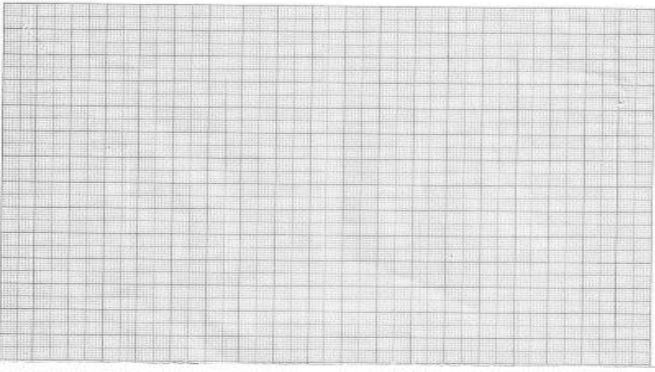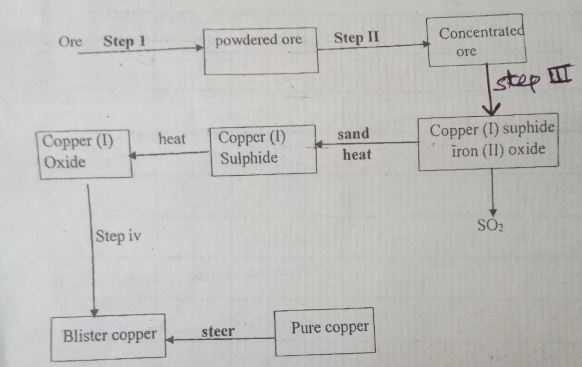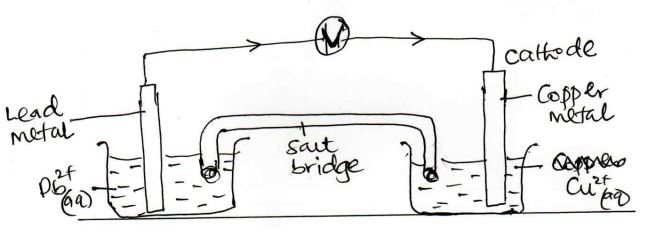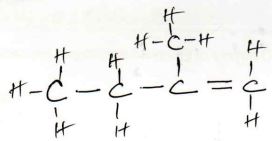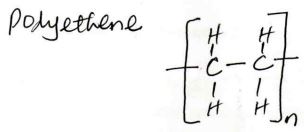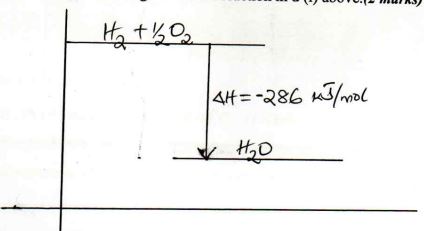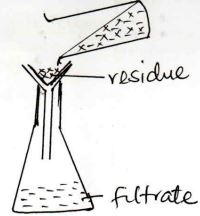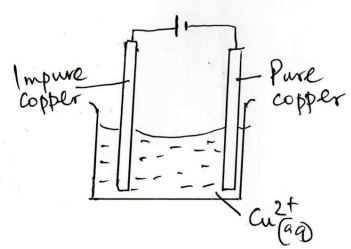INSTRUCTION TO CANDIDATES
- Answer all the questions in the spaces provided
- All working must be clearly shown where necessary.
-
- The grid below represents part of the periodic table. Study it and answer the questions that follow. The letters do not represent the actual symbols of the elements.
- Which element will require the least amount of energy to remove one of the outermost electrons? (1mk)
- Select the most reactive non- metal. (1mk)
- Which of the elements has the greatest tendency of forming covalent? Explain (2mks)
- What name is given to the family of elements to which elements O, T and V belong?(1mk)
- An element W has atomic number 15. Indicate the position of W on the grid. (1mk)
- Explain why the atomic radius of S is smaller than that of R. (1mks)
- Explain why the atomic radius of Z is smaller than its ionic radius. (1mk)
- Study the information given in the table below and answer question that follow.
Formula of compound NaCl MgCl2 AlCl3 SiCl4 PCl5 SCl2 Boiling point °C 1470 1420 Sublimes at 1800C 60 75 60 Melting point °C 800 710 -70 -90 -80 - Give two chlorides that are liquids at room temperature. Give a reason for your answer. (2mks)
- Give a possible reason why AlCl3 has much lower boiling point than MgCl2 although both Aluminum and Magnesium are metals. (1mks)
- The grid below represents part of the periodic table. Study it and answer the questions that follow. The letters do not represent the actual symbols of the elements.
- The table below gives standard reduction potentials for some half cells.
Half-cell Half-cell equation Eθ /V I Cr3+ (aq) + e- → Cr2+ (aq) -0.41 II Cd2+ (aq) + 2e- → Cd (s) -0.4 III Na+ (aq) + e- → Na (s) -2.71 IV Cu2+ (aq) + 2e- → Cu (s) 0.34 V Pb2+ (aq) + 2e- → Pb (s) -0.13 VI Br2 (aq) + 2e- → 2Br- (aq) 1.07 VII 2H+(aq) + 2e- → H2(g) 0 VIII Fe2+(aq) + 2e- → Fe(s) -0.44V IX O2(g) + 2H2O (l) + 4e- → 4OH-(aq) +0.40V X H2O2(aq) + 2H+(aq) + 2e- → 2H2O(l) +1.23V - Identify with reasons: (2mks)
- The strongest oxidizing agent.
- The strongest reducing agent.
- Draw an electrochemical cell from half-cells V and IV. (3mks)
- Write the equation and calculate the electromotive force for the electrochemical cell constructed from half-cells V and IV. (2 marks)
- Explain why it is not advisable to use aqueous sodium sulphate as the salt bridge in the electrochemical cell formed between half-cells V and IV. (1mark)
- Write the cell notation for an electrochemical cell made using half-cells V and VI. (1 mark)
- Identify with reasons: (2mks)
-
- Draw the structures of the following compounds. (2mks)
- 2 – methylbut-2-ene
- heptanoic acid
- Describe a physical test that can be used to distinguish between ethanol and ethene (2mks)
- Use the flow chart below to answer the questions that follow.
- Name
- The type of reaction that occurs in step VII. (1mk)
- Substance B (1mk)
- What conditions and reagents are necessary to convert CH3CH2OH to CH3CH2COOCH2CH3 in step II
Conditions (1mk)
Reagent (1mk) - Give the formula and name of substance C. (1mk)
- Give the reagent and conditions necessary for the reaction in step IV. (2mks)
-
- Draw and name the structure of polymer P. (1mk)
- Name one use of the polymer P. (1mk)
- Name
- Draw the structures of the following compounds. (2mks)
- Several students prepared hydrogen gas using different reagent
Student 1: Used Zinc granules and dil. Nitric (V) acid
Student 2: Used Zinc granules and dilute sulphuric acid and a catalyst.
Student 3. Used calcium and dilute sulphuric(VI) acid.
Student 4: Used copper and dilute hydrochloric acid.- State and explain the observation made in the set-ups for;
- Student 2. (1mk)
- Student 3 (2mks)
- Explain why no hydrogen was collect for set ups of student;
- 1 (1mk)
- 4 (1mk)
- Name the catalyst used by student 2. (1 mk)
- Write the equation for the reaction that took place in the set-up for student 2. (1mk)
- Explain why group 1 metals are not used to prepare hydrogen gas in the laboratory. (1mk)
- State two uses of hydrogen gas. (1 mk)
- State and explain the observation made in the set-ups for;
-
- In an experiment to determine the heat of combustion of ethanol the following data was collected.
Volume of water = 450cm3
Initial temperatures of water = 25°C Final temperature of water = 46.5°C
Mass of ethanol + lamp before heating = 125.5g
Mass of ethanol + lamp after heating = 124.0
Calculate:- Heat evolved during the experiment (Density of water = 1g/cm3, specific heat capacity of water = 4.2kJ/kg-1k-1. (2 marks)
- Molar heat of combustion of ethanol. (2mks) (C=12,O=16,H=1).
- Write the thermochemical equation for the complete combustion of ethanol. (1 mark)
- The molar heat of combustion obtained from an experiment like the one above is usually lower than the theoretical value. Explain. (2 marks)
- The molar heat of combustion of hydrogen is given as -286Kj/mol-2
- Write the thermochemical equation for the reaction. (1 mark)
- Draw an energy level diagram for the reaction in d (i) above.(2 marks)
- In an experiment to determine the heat of combustion of ethanol the following data was collected.
- In an experiment to determine the solubility of potassium chlorate, the following results were obtained.
Total volume of water added (cm3) 10 20 30 40 50 Mass of potassium chlorate (g) 5 5 5 5 5 Temperature at which crystals appear (°C) 80 65 55 45 30 Solubility of potassium chlorate (g/100 H2O) - Complete the table to show the solubility of potassium chlorate at different temperatures. (3 marks)
- Plot a graph of mass of potassium chlorate per 100g water against temperature at which crystals from. (3 marks)
- From the graph, determine:
- The solubility of potassium chlorate at 40°C. (1 mark)
- The temperature at which the solubility of potassium chlorate is 35g/100g water. (1 mark)
- Explain the shape of the graph. (1 mark)
- State one application of solubility and solubility curves. (1 mark)
- In the preparation of Copper carbonate, copper was burnt in air and the product collected. Dilute sulphuric acid was added and the mixture filtered and cooled. Sodium carbonate was added to the filtrate and the content filtered. The residue was washed and dried to give a green powder.
- Give the chemical name of the product formed when copper burns in air (1mk)
- Write a chemical equation for the formation of product. (1mk)
-
- Name filtrate collected after sodium carbonate was added (1mk)
- Name the green powder. (1mk)
- Write chemical equation for the reaction between product in (a) and acid. (1mk)
- Write an ionic equation to show the formation of the green powder (1mk)
- Write an equation to show what happened when green powder is strongly heated. (1mk)
- Using a diagram, describe how a salt can be obtained from the filtrate in c(i) above. (3mks)
- The diagram below is a flow chart for the extraction of copper. Study it and answer the question that follow.
- Give the name and formula of the major ore from which copper is extracted. (1mk)
- Give the name of the process carried out in step II and III. (1mk)
- Write equation for the reactions taking place in step III and IV. (2mks)
- Iron (ii) oxide is an impurity during extraction of copper. Write the equation for the reaction to show how it is removed. (1mk)
-
- Draw a well labelled diagram to show blister copper is purified to form pure copper. (2mks)
- Write the ionic equation for the anode and cathode reaction during purification of copper. (2 mks)
MARKING SCHEME
-
- The grid below represents part of the periodic table. Study it and answer the questions that follow. The letters do not represent the actual symbols of the elements.
- Which element will require the least amount of energy to remove one of the outermost electrons? (1mk)
- V
- Select the most reactive non- metal. (1mk)
- S
- Which of the elements has the greatest tendency of forming covalent? Explain (2mks)
- Q - has four valence electrons which takes part in the bonding.
What name is given to the family of elements to which elements O, T and V belong?(1mk) - Alakali metals
- Q - has four valence electrons which takes part in the bonding.
- An element W has atomic number 15. Indicate the position of W on the grid. (1mk)
- 2.8.5
- Explain why the atomic radius of S is smaller than that of R. (1mks)
- S - has a higher nuclear charge/protons than R hence pulls the outtermost energy level closer
- Explain why the atomic radius of Z is smaller than its ionic radius. (1mk)
- Z - gains electrons to form ions. Due to repulsion force of the incoming electrons and electrons in the energy levels of the atom.
- Which element will require the least amount of energy to remove one of the outermost electrons? (1mk)
- Study the information given in the table below and answer question that follow.
Formula of compound NaCl MgCl2 AlCl3 SiCl4 PCl5 SCl2 Boiling point °C 1470 1420 Sublimes at 1800C 60 75 60 Melting point °C 800 710 -70 -90 -80 - Give two chlorides that are liquids at room temperature. Give a reason for your answer. (2mks)
- SiCl4, PCl2, SCl2 (any two)
- Melting point below room temperaturen (25°C)
- Give a possible reason why AlCl3 has much lower boiling point than MgCl2 although both Aluminum and Magnesium are metals. (1mks)
- Aluiminium chloride forms simple molecular structure
- MgCl2 forms a giant ionic structure with strong electrosstatic forces.
- Give two chlorides that are liquids at room temperature. Give a reason for your answer. (2mks)
- The grid below represents part of the periodic table. Study it and answer the questions that follow. The letters do not represent the actual symbols of the elements.
- The table below gives standard reduction potentials for some half cells.
Half-cell Half-cell equation Eθ /V I Cr3+ (aq) + e- → Cr2+ (aq) -0.41 II Cd2+ (aq) + 2e- → Cd (s) -0.4 III Na+ (aq) + e- → Na (s) -2.71 IV Cu2+ (aq) + 2e- → Cu (s) 0.34 V Pb2+ (aq) + 2e- → Pb (s) -0.13 VI Br2 (aq) + 2e- → 2Br- (aq) 1.07 VII 2H+(aq) + 2e- → H2(g) 0 VIII Fe2+(aq) + 2e- → Fe(s) -0.44V IX O2(g) + 2H2O (l) + 4e- → 4OH-(aq) +0.40V X H2O2(aq) + 2H+(aq) + 2e- → 2H2O(l) +1.23V - Identify with reasons: (2mks)
- The strongest oxidizing agent.
H202 → most electropositive - The strongest reducing agent.
Na → most electropositive
- The strongest oxidizing agent.
- Draw an electrochemical cell from half-cells V and IV. (3mks)
- Write the equation and calculate the electromotive force for the electrochemical cell constructed from half-cells V and IV. (2 marks)
- Pb(s) + Cu2+(aq) → Pb2+(aq) + Cu(s)
+ 0.34 − (− 0.13) = + 0.47V
- Pb(s) + Cu2+(aq) → Pb2+(aq) + Cu(s)
- Explain why it is not advisable to use aqueous sodium sulphate as the salt bridge in the electrochemical cell formed between half-cells V and IV. (1mark)
- Lead (ii) ions will form insoluble lead (ii) sulphate with the sulphate ions.
- Write the cell notation for an electrochemical cell made using half-cells V and VI. (1 mark)
- Pb(s)Ι Pb2+(aq)ΙΙCu2+(aq)Ι Cu(s) Eθ = +0.47V
- Identify with reasons: (2mks)
-
- Draw the structures of the following compounds. (2mks)
- 2 – methylbut-2-ene
- heptanoic acid
- 2 – methylbut-2-ene
- Describe a physical test that can be used to distinguish between ethanol and ethene (2mks)
- Burn each separately with a nono-luminous flame.
- Ethanol burns with a blue flame
- Etheneburns with a yellow sooty flame
- Use the flow chart below to answer the questions that follow.
- Name
- The type of reaction that occurs in step VII. (1mk)
- Substance B (1mk)
- Chloroethane
- What conditions and reagents are necessary to convert CH3CH2OH to CH3CH2COOCH2CH3 in step II
Conditions (1mk)- Warming
- Drops of Concentrated Sulphuric acid
Reagent (1mk) - Propanoic acid
- Give the formula and name of substance C. (1mk)
- CH3CH2ONa Sodium ethoxide
- Give the reagent and conditions necessary for the reaction in step IV. (2mks)
- Reagent ⇒ Hydrogen gas
- Condition ⇒ Nickel/daudanium catalyst
150°C − 250°C (any within the range)
-
- Draw and name the structure of polymer P. (1mk)
- Name one use of the polymer P. (1mk)
- Used as packaging bags
- Draw and name the structure of polymer P. (1mk)
- Name
- Draw the structures of the following compounds. (2mks)
- Several students prepared hydrogen gas using different reagent
Student 1: Used Zinc granules and dil. Nitric (V) acid
Student 2: Used Zinc granules and dilute sulphuric acid and a catalyst.
Student 3. Used calcium and dilute sulphuric(VI) acid.
Student 4: Used copper and dilute hydrochloric acid.- State and explain the observation made in the set-ups for;
- Student 2. (1mk)
- More bubbbling/effervescence occurred
- Vigorous reaction due to the presence of catalyst that speeds up the reaction.
- Student 3 (2mks)
- Bubbling occured and then stopped
- Due to formation of insoluble CaSo4 that coats the calcium
- Student 2. (1mk)
- Explain why no hydrogen was collect for set ups of student;
- 1 - Hydrogen gas produced was oxidised by dilute nitric (v) acid to water (1mk)
- 4 - Copper is less raective than hydrogen hence cannot displace it(1mk)
- Name the catalyst used by student 2. (1 mk)
- Crystals copper(ii) sulphate
- Write the equation for the reaction that took place in the set-up for student 2. (1mk)
- Zn(s) + H2SO4(aq) → ZnSO4(aq) + H2(g)
- Explain why group 1 metals are not used to prepare hydrogen gas in the laboratory. (1mk)
- Will react with dilute acids explosively
- State two uses of hydrogen gas. (1 mk)
- Manufacture of margarine
- As rocket fuel
- Manufacture of ammonia
- In oxy-hydrogen flame
- In weather ballons
- State and explain the observation made in the set-ups for;
-
- In an experiment to determine the heat of combustion of ethanol the following data was collected.
Volume of water = 450cm3
Initial temperatures of water = 25°C Final temperature of water = 46.5°C
Mass of ethanol + lamp before heating = 125.5g
Mass of ethanol + lamp after heating = 124.0
Calculate:- Heat evolved during the experiment (Density of water = 1g/cm3, specific heat capacity of water = 4.2kJ/kg-1k-1. (2 marks)
450 x 4.2 x 21.5 = − 40.635kJ
1000 - Molar heat of combustion of ethanol. (2mks) (C=12,O=16,H=1).
Mass of ethanol = 1.5g
RMM of ethanol ⇒ C2H5OH = 24 + 6 + 16 = 46
1.5g → 40.635KJ
4.6g →
4.6 x 40.635 = 1246.14KJ/mol
1.5
- Heat evolved during the experiment (Density of water = 1g/cm3, specific heat capacity of water = 4.2kJ/kg-1k-1. (2 marks)
- Write the thermochemical equation for the complete combustion of ethanol. (1 mark)
C2H5OH(l) + 3O2(g) → CO2(g) + H2O ΔH = −1246.14 KJ/mol - The molar heat of combustion obtained from an experiment like the one above is usually lower than the theoretical value. Explain. (2 marks)
- Some of the heat produced was absorbed by the apparatus
- Some heat got lost to the sorrounding environments
- The molar heat of combustion of hydrogen is given as -286Kj/mol-2
- Write the thermochemical equation for the reaction. (1 mark)
H2(g) + ½O2(g) → 2H2O ΔH = − 286kJ/mol - Draw an energy level diagram for the reaction in d (i) above.(2 marks)
- Write the thermochemical equation for the reaction. (1 mark)
- In an experiment to determine the heat of combustion of ethanol the following data was collected.
- In an experiment to determine the solubility of potassium chlorate, the following results were obtained.
Total volume of water added (cm3) 10 20 30 40 50 Mass of potassium chlorate (g) 5 5 5 5 5 Temperature at which crystals appear (°C) 80 65 55 45 30 Solubility of potassium chlorate (g/100 H2O) 50 25 16.7 12.5 10 - Complete the table to show the solubility of potassium chlorate at different temperatures. (3 marks)
- Plot a graph of mass of potassium chlorate per 100g water against temperature at which crystals from. (3 marks)
- From the graph, determine:
- The solubility of potassium chlorate at 40°C. (1 mark)
- 12g/100gH2O
- The temperature at which the solubility of potassium chlorate is 35g/100g water. (1 mark)
- 72°C
- The solubility of potassium chlorate at 40°C. (1 mark)
- Explain the shape of the graph. (1 mark)
- Solubility increase with increase in temperature
- State one application of solubility and solubility curves. (1 mark)
- Fractional distillation
- In the preparation of Copper carbonate, copper was burnt in air and the product collected. Dilute sulphuric acid was added and the mixture filtered and cooled. Sodium carbonate was added to the filtrate and the content filtered. The residue was washed and dried to give a green powder.
- Give the chemical name of the product formed when copper burns in air (1mk)
- Copper (iv) oxide
- Write a chemical equation for the formation of product. (1mk)
- 2Cu(s) + O2(g) → 2CuO(s)
-
- Name filtrate collected after sodium carbonate was added (1mk)
- Sodium sulphate
- Name the green powder. (1mk)
- Copper (ii) carbonate
- Name filtrate collected after sodium carbonate was added (1mk)
- Write chemical equation for the reaction between product in (a) and acid. (1mk)
- CuO(s) + H2SO4(aq) → CuSO4 + H2O(s)
- Write an ionic equation to show the formation of the green powder (1mk)
- Cu2+(aq) + CO2−3(aq) → CuCO3(s)
- Write an equation to show what happened when green powder is strongly heated. (1mk)
- CuCO3(s) → CuO(s) + CO2(g)
- Using a diagram, describe how a salt can be obtained from the filtrate in c(i) above. (3mks)
- Give the chemical name of the product formed when copper burns in air (1mk)
- The diagram below is a flow chart for the extraction of copper. Study it and answer the question that follow.
- Give the name and formula of the major ore from which copper is extracted. (1mk)
- Copper pyrites CuFeS2
- Give the name of the process carried out in step II and III. (1mk)
I - Froth floatation
II - Roasting - Write equation for the reactions taking place in step III and IV. (2mks)
- 2 CuFeS2(s) + 3O2(g) → 2Cu2S(s) + 2FeO(s) + 2SO2(g)
- 2Cu2S(s) + 2CuO → 6Cu + SO2
- Iron (ii) oxide is an impurity during extraction of copper. Write the equation for the reaction to show how it is removed. (1mk)
- FeO(s) + SiO2(s) → FeSiO3
-
- Draw a well labelled diagram to show blister copper is purified to form pure copper. (2mks)
- Write the ionic equation for the anode and cathode reaction during purification of copper. (2 mks)
- Cu(s) → Cu2+(aq) + 2e− Anode
- Cu2+ 2e− → Cu(s) Cathode
- Draw a well labelled diagram to show blister copper is purified to form pure copper. (2mks)
- Give the name and formula of the major ore from which copper is extracted. (1mk)
Download Chemistry Paper 2 Questions and Answers - Lanjet Joint Mock Exams 2023.
Tap Here to Download for 50/-
Get on WhatsApp for 50/-
Why download?
- ✔ To read offline at any time.
- ✔ To Print at your convenience
- ✔ Share Easily with Friends / Students

